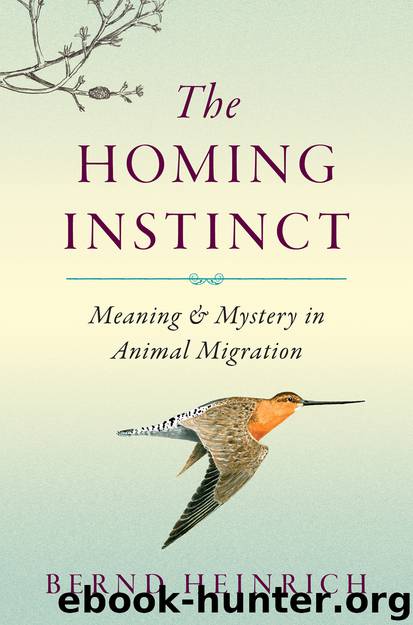The Homing Instinct by Bernd Heinrich

Author:Bernd Heinrich
Language: eng
Format: epub
Publisher: Houghton Mifflin Harcourt
A just-hatched broad-winged hawk on a freshly inserted green fern frond. No greens are added during the month-long incubation, but after the young hatch, the greens are brought almost daily until the young fledge.
I have on occasion looked into starling nests and had dissected one nest into its component parts and counted the number and color of the feathers it contained, to contrast them with those in a nest of tree swallows in an adjacent nest box (the starling had mostly brown feathers, the swallows almost exclusively white), but I found not a single green sprig in it. On the other hand, I found huge fresh green ferns and cedar sprigs lining the nest of the broad-winged hawk. These greens were so big, so prominent, and so fresh that they “knocked my eyes out” in their conspicuousness, yet I knew of no studies that examined the phenomenon of covering the entire lining of a nest with greens.
“My” hawk nest was located about ten meters up in the triple crotch of a sugar maple tree. Broad-winged hawks build a rough nest structure of sticks, and they line the nest mold with chips of dry bark. Finished with this lining, these birds, like most others, do nothing further at the nest after laying their eggs except incubate for about a month. However, in the hawk nest that I climbed up to examine almost every other day, there was something unusual: it was only after the young hatched that the nest contained the foot-long fresh green fronds of ferns and cedars. Even stranger, the hawks continued to bring fresh greens about every day or two for the next month until the young fledged. Were these greens some kind of remedy to discourage bugs?
The chronology of the insertion of the greens alone precludes any likely involvement of the various hypotheses previously proposed. Furthermore, in comparison with the amounts of greens incorporated in the starling nests, those in the hawk nest were massive. Since the greens were routinely and consistently replenished only after the young hatched, it had to do with the young. But what? My so-far-untested hypothesis is that the greens serve to provide a clean surface for the meat that the hawks bring in for food.
Hawks routinely bring a surplus of food into the nest for the young and leave it on the nest platform for them eventually to dismember and eat. This behavior would be comparable to a human parent routinely lugging in a hunk of beef and dropping it onto the floor of the home to then let the kids scrabble over it. Broad-winged hawks have their young in the hottest part of the summer, and meat that is not immediately eaten can spoil quickly if infected with bacteria. Uneaten meat scraps and a soiled “floor” seeded with bacteria that had multiplied from previous meals would hasten spoilage. A layer of greens, replaced frequently, would prevent debris and soiled material from accumulating and so retard food spoilage.
We too use herbs, chemical sprays, and swatters to keep the bug crowd as well as bacteria at bay.
Download
This site does not store any files on its server. We only index and link to content provided by other sites. Please contact the content providers to delete copyright contents if any and email us, we'll remove relevant links or contents immediately.
| Cell Biology | Developmental Biology |
| Entomology | Marine Biology |
| Microbiology | Molecular Biology |
| Biostatistics |
Sapiens: A Brief History of Humankind by Yuval Noah Harari(14252)
The Tidewater Tales by John Barth(12608)
Mastermind: How to Think Like Sherlock Holmes by Maria Konnikova(7227)
Do No Harm Stories of Life, Death and Brain Surgery by Henry Marsh(6890)
The Thirst by Nesbo Jo(6826)
Why We Sleep: Unlocking the Power of Sleep and Dreams by Matthew Walker(6618)
Life 3.0: Being Human in the Age of Artificial Intelligence by Tegmark Max(5474)
Sapiens by Yuval Noah Harari(5294)
The Longevity Diet by Valter Longo(5019)
The Body: A Guide for Occupants by Bill Bryson(4974)
The Rules Do Not Apply by Ariel Levy(4861)
The Immortal Life of Henrietta Lacks by Rebecca Skloot(4525)
Animal Frequency by Melissa Alvarez(4395)
Why We Sleep by Matthew Walker(4360)
The Hacking of the American Mind by Robert H. Lustig(4318)
Yoga Anatomy by Kaminoff Leslie(4305)
All Creatures Great and Small by James Herriot(4232)
Double Down (Diary of a Wimpy Kid Book 11) by Jeff Kinney(4207)
Barron's AP Biology by Goldberg M.S. Deborah T(4097)
